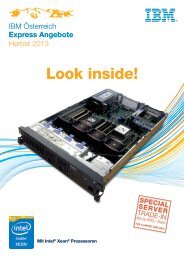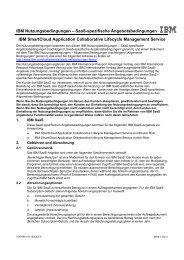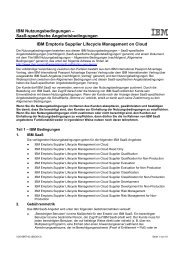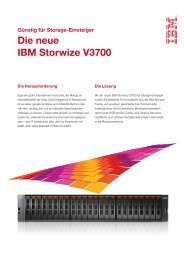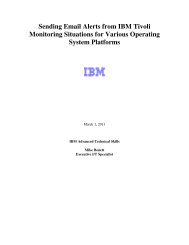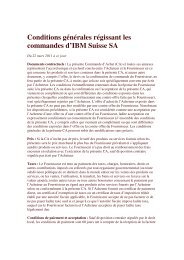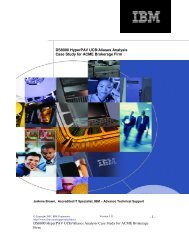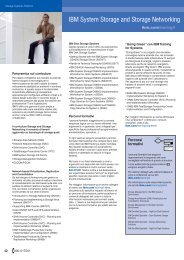Provide continuous access to critical business data with ... - IBM
Provide continuous access to critical business data with ... - IBM
Provide continuous access to critical business data with ... - IBM
Create successful ePaper yourself
Turn your PDF publications into a flip-book with our unique Google optimized e-Paper software.
<strong>IBM</strong> System S<strong>to</strong>rage<br />
<strong>Provide</strong> <strong>continuous</strong> <strong>access</strong> <strong>to</strong> <strong>critical</strong> <strong>business</strong> <strong>data</strong><br />
<strong>with</strong> information availability capabilities from <strong>IBM</strong>
The <strong>to</strong>ughest <strong>data</strong> s<strong>to</strong>rage challenge for many organizations is<br />
information availability, ensuring that the information necessary<br />
<strong>to</strong> the enterprise is available when and where it’s needed. In<br />
fact, information availability is a prerequisite <strong>to</strong> having effective<br />
information retention and compliance strategies in an information<br />
infrastructure. While having a sound information compliance<br />
strategy is <strong>critical</strong> for compliance <strong>with</strong> regulations and policies<br />
governing <strong>data</strong> integrity, that information must first be available<br />
when it’s needed. Ultimately, it doesn’t matter how carefully<br />
archived or well-organized the <strong>data</strong> is <strong>with</strong>in an organization if<br />
the people who need it at any given time can’t <strong>access</strong> it.<br />
To help organizations meet their information availability needs,<br />
<strong>IBM</strong> has built high availability features and technologies in<strong>to</strong> our<br />
information infrastructure solutions. These solutions, along <strong>with</strong><br />
<strong>IBM</strong> Global Services, are designed <strong>to</strong> help deliver <strong>continuous</strong><br />
and reliable <strong>access</strong> <strong>to</strong> the information organizations rely on.<br />
●<br />
●<br />
●<br />
The pervasiveness of e-<strong>business</strong>, along <strong>with</strong> increased<br />
expectations from global cus<strong>to</strong>mers, has made it unacceptable<br />
for certain types of information <strong>to</strong> be unavailable <strong>to</strong><br />
cus<strong>to</strong>mers and partners, even briefly.<br />
Faced <strong>with</strong> increasing competition in this global marketplace<br />
and the ever-increasing speed of <strong>business</strong> transactions,<br />
organizations need high information availability in<br />
order <strong>to</strong> enable <strong>business</strong> flexibility and quick decision<br />
making.<br />
Compliance <strong>with</strong> various regulations governing the<br />
integrity of information requires that information for<br />
audits be immediately and easily available.<br />
The right information infrastructure can help provide a level of<br />
information availability that enables organizations <strong>to</strong> operate<br />
more effectively and cost-efficiently in the presence of these<br />
driving forces.<br />
What makes it so <strong>critical</strong>—and, at the same time, so<br />
challenging—<strong>to</strong> provide <strong>continuous</strong> <strong>access</strong> <strong>to</strong> information<br />
<strong>to</strong>day? A number of forces are driving the urgency of high information<br />
availability.<br />
●<br />
More <strong>business</strong>es are operating globally, which creates a<br />
complex, distributed IT environment that is characterized<br />
not only by vast amounts of <strong>data</strong>, but also by many types<br />
of <strong>data</strong> in many different places.<br />
Thinking beyond disaster recovery<br />
People often think of information availability as a component of<br />
disaster recovery. A disaster that destroys vast amounts of work<br />
and <strong>data</strong>, rendering it permanently unavailable <strong>to</strong> a <strong>business</strong>, is<br />
<strong>with</strong>out question the most devastating of <strong>business</strong> events. But<br />
it’s not the only circumstance that raises issues of availability.<br />
The reality is that conditions affecting information availability<br />
exist along a continuum. At one extreme is a hurricane, fire, or<br />
other disaster destroying a physical environment; at the other is<br />
2
the prospect of a more limited disruption, such as a power outage<br />
or component failure. But each can have an equally debilitating<br />
effect on a <strong>business</strong>—and one is more likely <strong>to</strong> occur at<br />
any given time than the other. For this reason, the information<br />
infrastructure must include a strategy not just for disaster recovery,<br />
but also for dealing <strong>with</strong> less dramatic but probably more<br />
frequent events that can interfere <strong>with</strong> information availability.<br />
Just as there is a continuum of conditions affecting availability,<br />
there is also a range of types of information <strong>to</strong> which <strong>business</strong>es<br />
need <strong>access</strong>. Some information that is rendered<br />
unavailable for a few hours may have more disastrous consequences<br />
for a <strong>business</strong> than other information that is permanently<br />
destroyed. The impact of the event is not necessarily<br />
aligned <strong>with</strong> the extent of the disaster; a cup of coffee spilled on<br />
a <strong>critical</strong> server could conceivably be worse than a fire in<br />
another area of the facility. The information infrastructure must<br />
take in<strong>to</strong> account the relative importance of the <strong>data</strong> and be<br />
able <strong>to</strong> prioritize it appropriately <strong>to</strong> better meet high availability<br />
requirements.<br />
Four key contribu<strong>to</strong>rs <strong>to</strong> information availability<br />
Understanding that information availability means more than<br />
disaster recovery, <strong>IBM</strong> has identified four key contribu<strong>to</strong>rs <strong>to</strong><br />
information availability—information infrastructure solutions that<br />
can help support your high information availability objectives:<br />
s<strong>to</strong>rage management, s<strong>to</strong>rage virtualization, <strong>business</strong> continuity,<br />
and <strong>data</strong> protection.<br />
S<strong>to</strong>rage management<br />
To effectively manage the significant amounts of <strong>data</strong> in many<br />
organizations <strong>to</strong>day, particularly when they represent wide variations<br />
in <strong>business</strong> priority, the information infrastructure must<br />
have extensive management capabilities <strong>to</strong> help simplify and<br />
streamline management tasks. The first step is <strong>to</strong> centralize the<br />
management of <strong>data</strong> s<strong>to</strong>rage at a single point of control, so<br />
that no matter how many kinds of <strong>data</strong> reside in how many<br />
places, all of it can be managed effectively from one place.<br />
<strong>IBM</strong> TotalS<strong>to</strong>rage® Productivity Center, <strong>IBM</strong>’s end-<strong>to</strong>-end disk<br />
management solution, enables these centralized s<strong>to</strong>rage management<br />
capabilities. This integrated information infrastructure<br />
management suite allows you <strong>to</strong> manage capacity utilization,<br />
performance and availability of s<strong>to</strong>rage systems, file systems<br />
and <strong>data</strong>bases, all from a common console.<br />
3
<strong>IBM</strong> also provides tape virtualization through the<br />
<strong>IBM</strong> Virtualization Engine TS7700 and <strong>IBM</strong> Virtualization<br />
Engine TS7500, which are virtual tape solutions for mainframe<br />
and open systems servers, respectively, that are designed <strong>to</strong><br />
optimize tape processing. Through the implementation of a fully<br />
integrated tiered s<strong>to</strong>rage hierarchy of disk and tape, the benefits<br />
of both technologies can be leveraged <strong>to</strong> help enhance performance<br />
and provide the capacity needed for <strong>to</strong>day’s backup<br />
and tape processing requirements.<br />
S<strong>to</strong>rage virtualization<br />
A centralized point of control is the launching point for key<br />
capabilities that can directly affect availability in information<br />
infrastructures. Chief among these capabilities is s<strong>to</strong>rage virtualization,<br />
which allows you <strong>to</strong> pool multiple s<strong>to</strong>rage resources as<br />
if they were a single s<strong>to</strong>rage device. Virtualization makes <strong>data</strong><br />
easier <strong>to</strong> manage, enabling more flexibility <strong>to</strong> respond <strong>to</strong> changing<br />
<strong>data</strong> requirements. <strong>IBM</strong> System S<strong>to</strong>rage SAN Volume<br />
Controller is a s<strong>to</strong>rage virtualization system that is designed <strong>to</strong><br />
support improved resource utilization, improved s<strong>to</strong>rage management,<br />
and improved information availability. SAN Volume<br />
Controller enables you <strong>to</strong> combine your s<strong>to</strong>rage systems in<strong>to</strong> a<br />
single reservoir of capacity, and allows you <strong>to</strong> make changes <strong>to</strong><br />
the information infrastructure <strong>with</strong>out disrupting the applications<br />
that use the <strong>data</strong>.<br />
S<strong>to</strong>rage virtualization delivers better information and application<br />
availability in several ways. It makes it possible <strong>to</strong> move <strong>data</strong><br />
<strong>with</strong>out disrupting operations, since it helps eliminate the downtime<br />
frequently caused by <strong>data</strong> movement in non-virtualized<br />
environments. For organizations planning <strong>to</strong> use tiered s<strong>to</strong>rage<br />
<strong>to</strong> control costs, virtualization makes deployment easier by<br />
enabling <strong>data</strong> <strong>to</strong> move between tiers <strong>with</strong>out disruption while<br />
also providing common management capabilities for all tiers.<br />
When s<strong>to</strong>rage is virtualized, <strong>access</strong> <strong>to</strong> information does not<br />
require knowledge of the physical location of the information.<br />
Virtualization separates the logical view of information from its<br />
physical location, enabling administra<strong>to</strong>rs <strong>to</strong> focus on information<br />
itself and how it can be used, rather than where information<br />
is s<strong>to</strong>red.<br />
4
Business continuity<br />
The goal of <strong>business</strong> continuity is <strong>to</strong> enable organizations <strong>to</strong><br />
continue <strong>to</strong> operate under any circumstances. A broad spectrum<br />
of features, including redundant and hot-swappable components<br />
and RAID protection, can help enable <strong>continuous</strong><br />
operations by eliminating single points of failure, supporting high<br />
information availability in the process. <strong>IBM</strong>’s high-performance<br />
s<strong>to</strong>rage solutions offer industry-leading <strong>business</strong> continuity features<br />
<strong>to</strong> help support our cus<strong>to</strong>mers’ high information availability<br />
objectives.<br />
Mirroring is another key <strong>business</strong> continuity technology that can<br />
help ensure information availability. This technology allows<br />
organizations <strong>to</strong> instantly copy or “mirror” key information from<br />
one location <strong>to</strong> another location. Mirroring <strong>data</strong> can help ensure<br />
<strong>continuous</strong> <strong>business</strong> operations, even in the event of a complete<br />
<strong>data</strong> loss. Mirroring technology on SAN Volume Controller<br />
includes Metro Mirror capabilities for replicating <strong>data</strong> <strong>to</strong> another<br />
location in the same “metropolitan” area, and Global Mirror<br />
capabilities that support <strong>data</strong> replication over extended distances.<br />
Mirroring technologies are also available on a wide<br />
range of <strong>IBM</strong> enterprise and midrange s<strong>to</strong>rage devices including<br />
the DS4000, DS5000, DS8000, XIV®, TS7700 and N series<br />
products.<br />
Data protection<br />
Today’s organizations face the ongoing challenge of effectively<br />
protecting and retaining very large—and growing—quantities of<br />
information. This growth drives the need for cost-effective and<br />
energy-efficient s<strong>to</strong>rage. Tape-based s<strong>to</strong>rage is both highly<br />
energy-efficient and a cost-effective way of addressing this<br />
challenge. <strong>IBM</strong> offers a comprehensive tape s<strong>to</strong>rage product<br />
line, from entry-level <strong>to</strong> enterprise solutions, providing comprehensive<br />
<strong>data</strong> protection and the lowest power and cooling s<strong>to</strong>rage<br />
available <strong>to</strong>day.<br />
Assessing your risk<br />
How great is your risk for information availability issues? Best<br />
practices call for organizations <strong>to</strong> frequently take s<strong>to</strong>ck of the<br />
changing circumstances of the <strong>business</strong> in order <strong>to</strong> effectively<br />
gauge risk.<br />
●<br />
●<br />
●<br />
●<br />
●<br />
What information availability issues have you experienced<br />
in the past? What strategies are in place <strong>to</strong> mitigate the<br />
potential for similar issues in the future?<br />
What single points of failure exist in your information<br />
infrastructure? What <strong>critical</strong> <strong>data</strong> is at risk as a result?<br />
How might a <strong>data</strong> availability problem affect <strong>business</strong><br />
operations?<br />
Have you made provisions for disaster recovery? Have you<br />
made provisions for lesser <strong>business</strong> interruptions?<br />
Have you had any recent mergers or acquisitions that<br />
could increase your risk <strong>with</strong> regard <strong>to</strong> information<br />
availability?<br />
Are there any new legislative and audit requirements relevant<br />
<strong>to</strong> information availability that need <strong>to</strong> be addressed?<br />
5
Steps <strong>to</strong> information availability<br />
High information availability is <strong>with</strong>in your reach. Depending on<br />
your current infrastructure and processes, it may be accomplished<br />
easily, or it may require a more concerted effort. To help<br />
organizations move <strong>to</strong>ward improved information availability,<br />
<strong>IBM</strong> recommends a phased approach. This roadmap breaks<br />
the overarching goal in<strong>to</strong> distinct tasks that build on each other<br />
as you move through the process.<br />
Step 1: Architect for resiliency<br />
The first step is <strong>to</strong> design an information infrastructure that<br />
leverages <strong>to</strong>day’s best practices in high availability. This architecture<br />
may integrate <strong>IBM</strong> disk and tape solutions that are<br />
designed for high availability, <strong>with</strong> fault-<strong>to</strong>lerant features that<br />
minimize hardware-related risks.<br />
Step 2: Virtualize s<strong>to</strong>rage systems<br />
Once the s<strong>to</strong>rage components are in place, the next step is <strong>to</strong><br />
implement a s<strong>to</strong>rage virtualization strategy that leverages your<br />
existing s<strong>to</strong>rage investments. With <strong>IBM</strong> SAN Volume Controller,<br />
you can consolidate your heterogeneous systems in<strong>to</strong> one easily<br />
managed pool—and help eliminate information silos that can<br />
hinder <strong>business</strong> activities. Tape Virtualization helps <strong>to</strong> reduce or<br />
eliminate a number of bottlenecks that may be present in a tape<br />
environment, which can help <strong>to</strong> reduce backup and res<strong>to</strong>re<br />
times.<br />
Step 3: Centralize management <strong>to</strong>ols<br />
Progressing logically from virtualization of s<strong>to</strong>rage systems, the<br />
next step is <strong>to</strong> centralize management of the information infrastructure<br />
through a single point of control. Centralized management<br />
through <strong>IBM</strong> TotalS<strong>to</strong>rage Productivity Center offers<br />
organizations numerous benefits, including improved productivity,<br />
increased flexibility and reduced IT complexity.<br />
Step 4: Au<strong>to</strong>mate operational tasks<br />
With a virtualized and fault-<strong>to</strong>lerant information infrastructure in<br />
place, managed from a central point of control, organizations<br />
can leverage <strong>to</strong>ols and technologies <strong>to</strong> au<strong>to</strong>mate operational<br />
tasks, minimizing human error, improving productivity and<br />
enhancing performance. Optimizing the s<strong>to</strong>rage environment<br />
through au<strong>to</strong>mation can help enhance information availability<br />
across the infrastructure.<br />
Consulting services <strong>to</strong> meet your needs<br />
<strong>IBM</strong> Global Services teams offer flexible services that can help<br />
organizations meet a wide range of information availability<br />
needs. For example, <strong>IBM</strong>’s resilience consulting can help you<br />
identify and fill gaps in your current <strong>business</strong> continuity strategy<br />
and guide you through the complex standards, practices and<br />
regulations that affect your <strong>business</strong> continuity strategy. These<br />
teams can work <strong>with</strong> you <strong>to</strong> develop and manage a program<br />
that is aligned <strong>to</strong> your specific <strong>business</strong> needs, resulting in a<br />
more productive <strong>business</strong> environment.<br />
6
<strong>IBM</strong>’s information protection services provide a range of onsite,<br />
offsite and hybrid <strong>data</strong> protection services, helping you implement<br />
a plan based on your priorities for backup, retention and<br />
retrieval, so you can have <strong>access</strong> <strong>to</strong> the information you need<br />
virtually anywhere, anytime. These services deliver high levels of<br />
security and availability, helping organizations meet stringent<br />
standards for <strong>data</strong> protection, <strong>business</strong> and systems continuity,<br />
disaster recovery and regula<strong>to</strong>ry compliance.<br />
unique performance needs and budgets. By combining these<br />
solutions <strong>with</strong> industry-leading consulting services, <strong>IBM</strong> can<br />
provide turn-key solutions <strong>to</strong> help organizations meet a range of<br />
information availability requirements. Or we can provide targeted<br />
solutions that provide specific capabilities or address a specific<br />
need in your infrastructure. Whether you are facing an information<br />
availability crisis or simply want <strong>to</strong> enhance your risk management<br />
posture, <strong>IBM</strong> can help.<br />
End-<strong>to</strong>-end s<strong>to</strong>rage solutions<br />
<strong>IBM</strong>’s proven track record and extensive portfolio of offers and<br />
services can help organizations better manage, s<strong>to</strong>re, secure<br />
and share information across the enterprise. <strong>IBM</strong>’s integrated<br />
hardware and software solutions can help companies manage a<br />
wide variety of content, including documents, <strong>data</strong>bases and<br />
unstructured <strong>data</strong> such as e-mail, <strong>to</strong> meet each organization’s<br />
For more information<br />
To learn more about how <strong>IBM</strong> solutions can help your organization<br />
meet your information availability needs, contact your<br />
<strong>IBM</strong> representative or <strong>IBM</strong> Business Partner, or visit<br />
ibm.com/s<strong>to</strong>rage<br />
7
THE INFORMATION IN THIS DOCUMENT IS<br />
PROVIDED “AS-IS” WITHOUT ANY<br />
WARRANTY, EITHER EXPRESSED OR<br />
IMPLIED. <strong>IBM</strong> EXPRESSLY DISCLAIMS ANY<br />
WARRANTIES OF MERCHANTABILITY,<br />
FITNESS FOR A PARTICULAR PURPOSE OR<br />
NONINFRINGEMENT. <strong>IBM</strong> products are<br />
warranted according <strong>to</strong> the terms and<br />
conditions of the agreements (e.g.,<br />
<strong>IBM</strong> Cus<strong>to</strong>mer Agreement, Statement of Limited<br />
Warranty, International Program License<br />
Agreement, etc.) under which they are provided.<br />
References in this document <strong>to</strong> <strong>IBM</strong> products,<br />
programs or services does not imply that<br />
<strong>IBM</strong> intends <strong>to</strong> make such products, programs<br />
or services available in all countries in which<br />
<strong>IBM</strong> operates or does <strong>business</strong>. Any reference<br />
<strong>to</strong> an <strong>IBM</strong> program or product in this document<br />
is not intended <strong>to</strong> state or imply that only that<br />
program may be used. Any functionally<br />
equivalent program or product that does not<br />
infringe <strong>IBM</strong>’s intellectual property rights may be<br />
used instead. It is the user’s responsibility <strong>to</strong><br />
evaluate and verify the operation of any non-<br />
<strong>IBM</strong> product, program or service.<br />
Disclaimer: The cus<strong>to</strong>mer is responsible for<br />
ensuring compliance <strong>with</strong> legal requirements. It<br />
is the cus<strong>to</strong>mer’s sole responsibility <strong>to</strong> obtain<br />
advice of competent legal counsel as <strong>to</strong> the<br />
identification and interpretation of any relevant<br />
laws and regula<strong>to</strong>ry requirements that may<br />
affect the cus<strong>to</strong>mer’s <strong>business</strong> and any actions<br />
the reader may have <strong>to</strong> take <strong>to</strong> comply <strong>with</strong><br />
such laws. <strong>IBM</strong> does not provide legal advice or<br />
represent or warrant that its services or<br />
products will ensure that the cus<strong>to</strong>mer is in<br />
compliance <strong>with</strong> any law or regulation.<br />
© Copyright <strong>IBM</strong> Corporation 2008<br />
<strong>IBM</strong> Systems and Technology Group<br />
Route 100<br />
Somers, NY 10589<br />
U.S.A.<br />
Produced in the United States of America<br />
August 2008<br />
All Rights Reserved<br />
<strong>IBM</strong>, the <strong>IBM</strong> logo, ibm.com, DS8000, System<br />
S<strong>to</strong>rage, TotalS<strong>to</strong>rage, Virtualization Engine and<br />
XIV are trademarks or registered trademarks of<br />
International Business Machines Corporation in<br />
the United States, other countries, or both. If<br />
these and other <strong>IBM</strong> trademarked terms are<br />
marked on their first occurrence in this<br />
information <strong>with</strong> a trademark symbol (® or ),<br />
these symbols indicate U.S. registered or<br />
common law trademarks owned by <strong>IBM</strong> at the<br />
time this information was published. Such<br />
trademarks may also be registered or common<br />
law trademarks in other countries. A current list<br />
of <strong>IBM</strong> trademarks is available on the Web at<br />
“Copyright and trademark information” at<br />
ibm.com/legal/copytrade.shtml<br />
Other company, product and service names<br />
may be trademarks or service marks of others.<br />
This document could include technical<br />
inaccuracies or typographical errors. <strong>IBM</strong> may<br />
make changes, improvements or alterations <strong>to</strong><br />
the products, programs and services described<br />
in this document, including termination of such<br />
products, programs and services, at any time<br />
and <strong>with</strong>out notice. Any statements regarding<br />
<strong>IBM</strong>’s future direction and intent are subject <strong>to</strong><br />
change or <strong>with</strong>drawal <strong>with</strong>out notice, and<br />
represent goals and objectives only. The<br />
information contained in this document is<br />
current as of the initial date of publication only<br />
and is subject <strong>to</strong> change <strong>with</strong>out notice.<br />
<strong>IBM</strong> shall have no responsibility <strong>to</strong> update such<br />
information.<br />
<strong>IBM</strong> is not responsible for the performance or<br />
interoperability of any non-<strong>IBM</strong> products<br />
discussed herein. Performance <strong>data</strong> for <strong>IBM</strong> and<br />
non-<strong>IBM</strong> products and services contained in this<br />
document was derived under specific operating<br />
and environmental conditions. The actual results<br />
obtained by any party implementing such<br />
products or services will depend on a large<br />
number of fac<strong>to</strong>rs specific <strong>to</strong> such party’s<br />
operating environment and may vary<br />
significantly. <strong>IBM</strong> makes no representation that<br />
these results can be expected or obtained in<br />
any implementation of any such products or<br />
services.<br />
TSB03008-USEN-00



